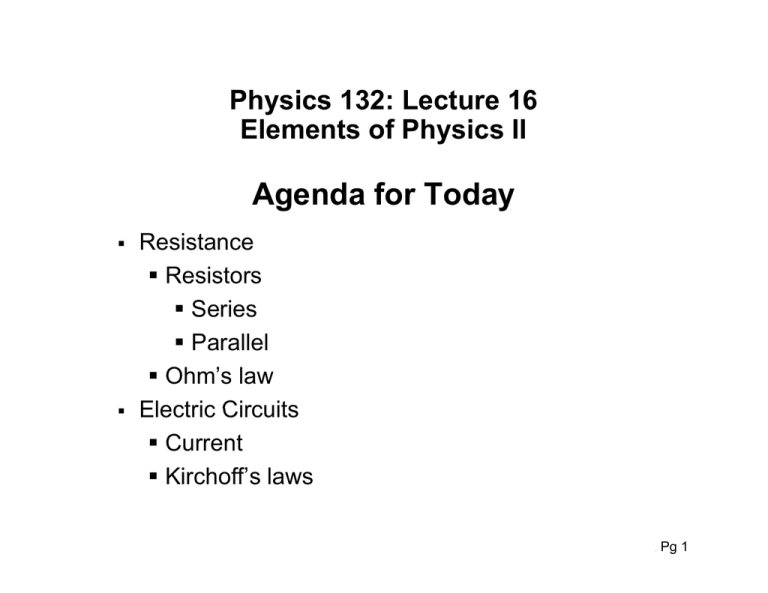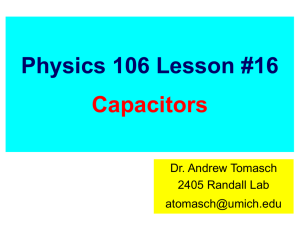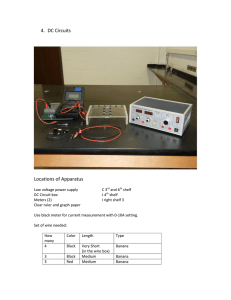Lecture slides with notes
advertisement

Physics ys cs 132: 3 Lecture ectu e 16 6 Elements of Physics II A Agenda d for f T Today d Resistance Resistors Series Parallel Ohm’s law Electric Circuits Current Kirchoff Kirchoff’ss laws Physics 201: Lecture 1, Pg 1 Clicker Question 1: A light g bulb is connected to a battery y in case A. In case B an identical light bulb is added in parallel. What happens to the brightness of the g bulb? original How do you suppose (a) it stays the same outlets in our homes are (b) it decreases wired? (c) it increases Physics 201: Lecture 1, Pg 2 Parallel wiring If two objects are in a circuit such that both ends of the object are connected, they are said to be in parallel. The current splits and travels through R1and R2 separately R1 R2 Voltage drop across resistors must be same as emf of the battery. Physics 201: Lecture 1, Pg 3 Resistors in parallel Two wires: Both ends of resistor are connected I1 + I2 = Ieq V1 = V2 = Veq R1 R2 Req Physics 201: Lecture 1, Pg 4 Clicker Question 2: Current flows through a lightbulb. If a wire is now connected across the bulb, what happens? a) all the current continues to flow through the bulb b) half the current flows through the wire, the other half continues through the bulb c) all the current flows through the wire d)) none of the above Question: If a path is present which offers less resistance than the other, will all the current flow through that path of only part of it? Physics 201: Lecture 1, Pg 5 Clicker Question 2: Question: If a path is present which offers less resistance than the other, will all the current flow through that path of only part of it? Physics 201: Lecture 1, Pg 6 Summary: Resistors in Series and Parallel Series Parallel V Req Parallel Series 1 Req 1 R1 R12 Req = R1 + R2 I Ieq = I1 + I2 V1 = V2 Veq = V1 + V2 I1 = I2 Physics 201: Lecture 1, Pg 7 Example p What is the equivalent resistance of this circuit? What is the current in all the resistors? Physics 201: Lecture 1, Pg 8 Example: A B 10 10 18 18 5 C 8 3.1 D 18 13.1 7.6 Physics 201: Lecture 1, Pg 9 C Parallel = Same Voltage! 18 R () 7.6 13 1 13.1 13.1 Simplest circuit in the world! D 12 V 7.6 18 I (A) 1.6 0.92 0.67 V (V) 12 12 12 Physics 201: Lecture 1, Pg 10 B Series = Same current! C 10 18 18 13.1 3.1 R () 7.6 13.1 18 3.1 10 I (A) 1.6 0.92 0.67 0.92 0.92 V (V) 12 12 12 2.85 9.2 Physics 201: Lecture 1, Pg 11 A Parallel = Same Voltage! B 10 10 18 18 5 R () 7.6 13.1 3.1 8 18 3.1 10 5 8 I (A) 1.6 0.92 0.67 0.92 0.92 0.57 0.36 V (V) 12 12 12 2.85 9.2 2.85 2.85 Physics 201: Lecture 1, Pg 12 Clicker Question 3: What is the equivalent resistance between points a and b? A. B. C. D. E. 51 42 24 13 20 Physics 201: Lecture 1, Pg 13 Clicker Question 3: Physics 201: Lecture 1, Pg 14 Where to get help Office hours: Meyertholen M 2-3 in my office 129A F 11 11-1pm 1pm in room 126 (tutorial style) Make appt. or just stop by Office hours: Harlow T 12-1 F 10-11 The Drop In Help Centre is in MP125 (TA has red lanyard): Monday to Thursday - 12:00 to 3:00 pm Friday 11:00 am to 2:00 pm Undergrad g tutors ((LM 204A)) M 4-5pm T 10 am -12 pm R 11 am-12 pm W and F 3-5pm Physics 201: Lecture 1, Pg 15 Clicker Question 4: Now remove the diagonal 24 Ω resistor resistor, leaving a total of four resistors. What effect does this have on the voltage difference across the 16 Ω resistor? (a) The voltage difference is greater w/o the resistor. (b) The voltage difference is unaffected w/o the resistor. (c) The voltage is smaller w/o the resistor resistor. Physics 201: Lecture 1, Pg 16 Clicker Question 4: Physics 201: Lecture 1, Pg 17 Energy Transfer in the Circuit, final As the charge moves through the resistor resistor, it loses energy in collisions with the atoms of the resistor The energy is transferred to internal energy When the charge returns, the net result is that some chemical energy of the battery has been delivered to the resistor and caused its temperature to rise Physics 201: Lecture 1, Pg 18 Energy and Power The power supplied by a battery is: The units of power are J/s or W. Physics 201: Lecture 1, Pg 19 Energy and Power Energy and Power The power dissipated by a resistor is: Or, in terms of the potential drop across the resistor: Question: What determines the brightness of the light bulbs? Current? Voltage? Resistance? Or some other factor? Physics 201: Lecture 1, Pg 20 Clicker Question 5: Rank the lightbulbs in terms of brightness. A. B. C. D. E. A>B>C A<B=C A<B<C A=B=C A>B=C Physics 201: Lecture 1, Pg 21 Clicker Question 6: The lightbulbs are identical. Initially both bulbs are glowing. What happens when the switch is closed? A. Nothing. B. A stays the same; B gets dimmer. C A gets C. t brighter; b i ht B stays the same. D Both get dimmer. D. dimmer E. A gets brighter; B goes out. Physics 201: Lecture 1, Pg 22 Clicker Question 9: Which bulb is brighter? g A. The e 60 W bu bulb. b B. The 100 W bulb. C Their brightnesses are C. the same. D. There There’s s not enough information to tell. E. I want to g go home. Physics 201: Lecture 1, Pg 23





